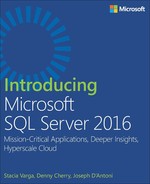0%
28Chapters
0-1Hours read
0kTotal Words
Book Description
With Microsoft SQL Server 2016, a variety of new features and enhancements to the data platform deliver breakthrough performance, advanced security, and richer, integrated reporting and analytics capabilities. In this ebook, we introduce new security features: Always Encrypted, Row-Level Security, and dynamic data masking; discuss enhancements that enable you to better manage performance and storage: TemDB configuration, query store, and Stretch Database; review several improvements to Reporting Services; and also describe AlwaysOn Availability Groups, tabular enhancements, and R integration.
Table of Contents
- Cover
- Title Page
- Copyright Page
- Contents
- Introduction
- Chapter 1. Faster queries
- Chapter 2. Better security
- Chapter 3. Higher availability
- Chapter 4. Improved database engine
- Chapter 5. Broader data access
- Chapter 6. More analytics
- Chapter 7. Better reporting
- Chapter 8. Improved Azure SQL Database
- Chapter 9. Introducing Azure SQL Data Warehouse
- About the authors
- Visit us today at
- Hear about it first
- Survey
- Free ebooks
- Code Snippets
